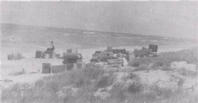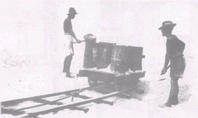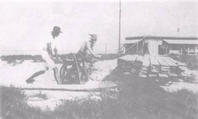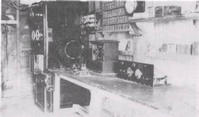


Seventy-Five Years at Willis Island
Preface
Foreword
Chapter 1: Willis Island Today
Chapter 2: Willis Island is Conceived
Chapter 3: Willis Island is Born
Chapter 4: The Early Years
Extract from Overseas Telecommunication Veterans Newsletter, Submitted by Bob Inglis
Letter from Eric Riethmuller to Lyndon Wade, September 1981
Later Letter from Eric Riethmuller to Lyndon Wade
Chapter 5: Life in the 1930s
Chapter 6: Willis Island at War (1941–42)
Chapter 7: After the War
Chapter 8: Willis Island—1960s Style
Chapter 9: The Value of Willis Island
Chapter 10: The Original Inhabitants
Appendix 1: Willis Island Milestones
Appendix 2: Willis Island Officers
Appendix 3: Log of Willis Island Observations, December 1922
Appendix 4: References
Index
Search
Help
Contact us

Letter from Eric Riethmuller to Lyndon Wade, September 1981
Between 1927 and 1932, Eric Riethmuller spent five tours of duty on the Island, some in company with a Mr F. Snape. Conditions then were still very primitive when compared with today's accommodation. Lyndon Wade, who served on the Island in 1976–77, 1978–79, 1980 and 1981 was so impressed with this length of duty that he sought out Eric, and in September 1981 received the following letter. At the time of writing (September 1981) Eric was 78 years of age. The details in the letter give a very good idea of how tough conditions were on Willis Island in those very early years. Some irrelevant side comments have been edited out.To say that your letter was a surprise is a gross understatement. Your inquiry as to what went on at Willis Is. in the earlier days also much and pleasantly surprising. For today so few people show interest in what went on out there say more than a decade ago. I figured out your letter came from VIQ [once the radio call sign for Willis Island—Ed] to a kindly being in VIT who typed and sent same on. Thanks to the K.B. Your contact on the HAM frequencies with Joe Ellis also pleasant. I've known Joe since 1945 and have often said to him in good humour 'Joe, you are one bod I can never get rid of for wherever we move the distance separation never stops us being in contact'.
For the 24 hours after receiving your letter I was back as VIQ most of the day and so much I had forgotten came back. 50 odd years ago in AWA were two departments—Marine and Coastal Radio. I was in Marine Radio operations at sea for AWA. We had the contract to supply the radio equipment and operators to all Aust. ships and some New Zealand. Twice yearly Marine asked for applications for Willis Is. and that's how I got started, just for the winter or 'off' season. The practice then was to send one radio Wallah and an offsider. Taken for the off season, 6 months, roughly May to November. The offsider was to function as cook and to generally be useful. Hann, aged about 45 was my offsider and we travelled Sydney to Willis on the Burns Philp Island steamer Morinda. On board was a New Guinea magistrate returning from leave. He was a boozer and kept Hann supplied with beer during the weeks trip. Hann was sozzled all the time. Arriving Willis, Hann was incapable of descending the gangway to the surfboat, so he was put over the side in the cargo sling together with the beer supplies given to him by the magistrate. Most of the bottles broken before reaching the shore. One moment never forgotten was when the Morinda was only a dot on the western horizon and soon to disappear. There I was, full of inexperience, a big heap of stores scattered on the beach amongst which sat the inebriated Hann. I sort of felt 'alone' but that feeling didn't last too long as there was plenty to do. Incidentally 3 weeks later Hann still appeared 'sickened' and hard to understand so I looked in one storeroom where there had been 6 bottles of port wine supplied as medical stores. Only 2 were left so that night I quietly buried them in the sand. Hann never enquired what became of them. One of my first jobs was to renew all the guys on the 2 aerial masts 80ft high they were. The reason for this was that during the previous summer the aerial had been struck by lightning which shattered most of the insulators and did some damage to the radio gear as well as uprooting the earth system. L. Day, the weather observer there at the time later told me that when the lightning struck he was in bed asleep, then leapt out of bed, both hands clutching his head crying 'FIREBALL'.

During the 'off' season we had to report to AWA once a week. Each Monday a 2 word message 'alls well' went south. Willis Island was then under the control of the Coastal Radio Superintendent. About that time AWA had developed and set up the 'Beam'. This was a radio telegraphic system between Aust. and England in opposition to the cable. When starting the cable was rather belittling of the beam and referred to as the 'bum'. Several years later they came closer together and that's how OTC come into the act. The cable and beam combined and that old saying 'when you cant beat them, join them' applied here.
The communications from 1921, when the station was established by Captain Davis (Commonwealth Director of Meteorology) (sic) in conditions of great contrast to what you have today, began with the call sign CGI. It worked Cooktown VIC. CGI later VIQ had 1 ½ kw rotary spark transmitter with low frequencies, 500KC and about 300KC (in old language 600 and 800 metres) [KC is now the old language. Short for kilocycles, KC has been replaced by kilohertz—Ed]. This was nice and easy during the off season. The transmitter was driven by a 5hp upright single cylinder petrol engine via a 110 volt DC generator and these two made such a racket in receive that engine had to be switched off to receive. You could just picture the operator trying to receive and transmit dashing in and out of engine room swinging crank handle with rapid enthusiasm, and after transmitting and switching off to impatiently wait for noise in receiver to recede and hoping VIC did not reply too quickly.
During the summer or cyclone season static was so bad after about 11am communications were just possible. The system used was for CGI to transmit the 3pm or later weather reports (5 letter code) three times each time repeating each word 3 times which meant each group was repeated 9 times. If VIC received the lot he would transmit a series of dashes and if something was missing he would transmit a series of dots, and CGI would do the 9 times over again. On occasions this meant carrying on for several hours until CGI gladly heard the series of dashes. When I went there first I think in 1927 we were still with VIC, not long after changed to VIT who had a much better 1kw transmitter.
Going back a little before leaving Sydney I spent several days at weather observatory where a man named Nelson initiated me into the mysteries of how to read the mercury barometer and look after the anemometer, barograph and thermograph. I sort of remember the barometer, temperature etc had to be read each day and recorded in certain books. For weeks on end the weather changed little, SE trades blew consistently and the sooty terns wailed all night and very little rain. On arrival there about May 1928 I found the station in a run down condition. Most things had been given over to the cockroaches, corrosion and humidity with sad results. One item completely ruined was the large medical stores. For that session, same later, practically all food was tinned or bottled. Things such as flour, sugar, biscuits, dried fruit were all done up in sealed cans to defeat the weevils and ants plus the humidity. We had a dozen or so hens that kept us in eggs. Hens were fed on wheat mostly and kept in a small yard to the north of the wireless hut. Both buildings were referred to as 'huts' though built of reinforced concrete. For cooking we had a 3 burner kero stove and a primus. Stove was needed for the bread making. We mostly were proud of the results with the bread. Yeast was the old grandma type, hops potato cork tied down in a bottle. When Hann missed his beer he used to take a mug of the yeast and pour it down his throat. At the end of the first session we were short of flour. Ration was half a slice per meal caused partly by the month late arrival of the Morinda which had run aground up New Guinea somewhere the previous trip.
Later I was there with Snape, also from the Marine, and sometimes we followed one another. He also was an eager beaver and we two put the station in order. Took a couple of years to do so. This even impressed the high command to such an extent that old Fisk ordered that we be given a bonus of 30 pounds for 'good work at Willis Island'. Weather men came with the November relief plus a second Radio Wallah. I stayed over the summer season. Weather men I lived with were Day and Dwyer from Melbourne and Kelly from Brisbane. Part of the weatherman's job was to fly an observation balloon each day and follow it with the theodolite. Kelly made a record of tracking a balloon to 50 000 feet but no one on the mainland believed him. Even in those days Venus was reckoned to be the Interloper. Before returning for my second trip towards the end of 1928, I spent several days in the AWA castle York Street making a short wave transmitter under the direction of Joe Reed one of the AWA engineers. When back on the Island, this little toy changed our whole communication. We transmitted on 32 metres, received VIT on 600 or 700. His glorious signal came in all over the static and dynamotor noises. We still had to run the engine and the 1½ kw set to obtain the 1000 or so volts for the SW set. This output was also 1kw. Snape and I were proud of our efficiency. As soon as 9am struck, VIT said go ahead. He had the land line kept open to Brisbane for the VIQ Rag and before 0905am such Rag was in the met office in Brisbane. Later we heard on grape vine this all broke down VIQ came in any old time. The Rag named after Mr Wragge who was one time the big wheel of the met office [Clement Wragge was Queensland Government Meteorologist at this time—Ed].
In my several years there, one cyclone came fairly close. Wind up to 75mph and barometer fell to 29.3. After I had been there for 6 months summer season 1930 to 1931 the High Command asked if I would stay on for another 12 months as they were changing the system to do away with the weather observer and would send up an additional Radio Wallah. Then he and I were to hold the fort for the next 12 months straight. I was to do the weather observing and the balloon flying discontinued. For how long afterward this system was followed I have not heard.
Sometime about 1930 the Queensland lighthouse steamers took over from the Morinda. We then either joined Cape York or the Cape Leeuwin at Brisbane. On the journey to Willis, we had a look at all the lighthouses on the coast up to Townsville before dashing out to Willis. On returning we usually put off at Cairns and travelled south to Sydney by train. [The 'Cape' boats were used for relief until 1990. The Leeuwin and York were replaced by the Cape Pillar, Cape Don and Cape Morton. These boats, primarily intended to service the lighthouses, were also used to service the Bureau's Coral Sea AWS network—but much later than in Eric's narrative—Ed]
I better not make this too long so will end with a list of questions.
- End of August on to September was mutton bird arrival. Do they still come?
- Do the furtive little rails dash in and out collecting crumbs fallen from the rich mans table?
- Does one of those mighty diesels run continuously?
- Do you have enough bread in the deep freeze for one season?
- Of the staff of 4 are all trained met men or is one perhaps a cook or handyman?
- Were the 2 old huts dumped in the sea plus 2 m big masts?
- Did the few coconut trees planted and established in 1932 grow to mature?
- When were the present buildings etc erected and did those two old huts serve until then?
- Does the tide go right out and leave main reef bare daytime during full moon in October?
- Are all the frigate birds, noddys, sooty terns, gannets still there?
- Do you still refer to the north and south end?
- Any sign of the wrecked lugger towards the south end or of the big washed up tree towards the north end?
- Do turtles still lay eggs there?
- Unusual visitors seen there . . . a flying fox, a peewit, any such your way?




Might as well throw in a few more remarks. When station just established the authorities thought it a good idea to have fresh meat and milk for the staff so a number of goats were taken there. Due to the coarse grass, salt laden fodder both the meat and milk were of such bad flavour as to be inedible. Goats bred up to 30 or so and before my time there was a rifle with ammo sent on the relief ship and the radio Wallah was instructed to shoot all the goats before ship left as rifle was NOT to stay there. This was done, but 6 weeks later, one solitary goat emerged from his hiding. Rather clever goat that.
About the birds, most of the men friendly to the birds and did a lot of 'watching'. I have still a collection of bird photographs and the taking, developing and printing was a pleasant diversion. One brave man though used to go in amongst the terns with a stick and slash around in all directions. [Deletion here of a sentence containing distasteful information—Ed] One item about frigate birds. You may have noticed the little red patch under the beaks of some. Well, in nesting season, this becomes very enlarged to the size of a football still remaining red in colour. I saw these at Canton Island where they had numerous nests in the bushes. As frigate birds not fully web footed, I caught one, took him into the water, half immersed him but he took off with the greatest of ease.
At the end of one OFF season our water supply ran low. Not enough left for bathing, this had to be done in the sea. Washing clothes was deferred. For one month we went entirely naked.
Your accommodation at present sounds like luxury holiday units. One item still lacking. I can't quite figure out why the summer trip lasts 7½ months while winter only 4½ months. During winter, how does staff of 4 remain occupied or does the upper air research consume a lot of time?
In my days the changeover took only 3 to 4 hours. The amphibious toy rushing from ship to shore sounds like a wonderful idea. When we are meeting later on I hope you will have a collection of photos of island buildings, staff, birds etc. To place alongside mine will be most interesting. After coming home in December, don't leave it too long before contacting.
Aufwiedersehen
Eric Riethmuller
People in Bright Sparcs - Davis, John King; Wragge, Clement Lindley
 |
Bureau of Meteorology |  |
© Online Edition Australian Science and Technology Heritage Centre and Bureau of Meteorology 2001
Published by Australian Science and Technology Heritage Centre, using the Web Academic Resource Publisher
http://www.austehc.unimelb.edu.au/fam/0608.html